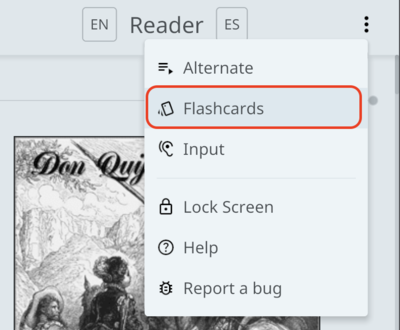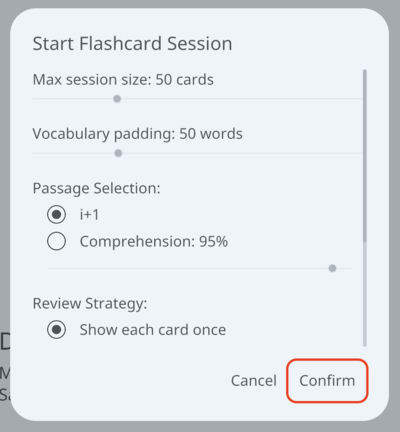Flashcards
Flashcards in SynchroTales are presented using the SuperMemo 2 algorithm based on the user's prior flashcard scores. This is similar to many other scheduling applications, however there are a few key differences which tailor the SynchroTales experience specifically to language learners.
Most importantly, SynchroTales flashcards are always shown in the context of the item from which the flashcard session was initiated. Individual flashcards are just "slices" of the aligned text between your chosen reference and target languages, which have been selected algorithmically based on prior scores. The parameters of the algorithm are configurable from the Flashcards session prompt, so you can tailor the experience to your preferences or learning style.
Flashcard scores are stored locally on your device and can be exported from the Progress screen.
We'll first look at the most basic example of a flashcard session to illustrate the overall process, then examine the impact of each session parameter individually.
Example flashcard session
A flashcard session can be started by selecting the "Flashcards" option from the action menu at the top right of the screen.

After selecting this option, the session configuration parameters will be shown. For the sake of simplicity, we'll proceed using the default parameters in this example:

After pressing confirm, the first flashcard will be shown, and the audio from the right (target) language will be played once. Let's examine each component of the flashcard:

A.
The text outlined in red labeled "A" is the passage selected from the target language text, and the token outlined in black (in this case the spanish word "Y") is the target token for the card. This target token is the word or phrase that the user is being prompted to evaluate their understanding of. Dictionary and audio behavior are the same here as in any other text shown in the Reader: click/tap to show any available dictionary entry, and double-click/tap to play the audio.
In this example, the user is prompted to evaluate understanding of the Spanish word "Y" in the given context.
B.
The buttons labeled 0-5 are used to record understanding of the target token, with the meaning of each button as follows:
- No understanding at all
- Incorrect, but the correct meaning seemed familiar
- Incorrect, but the correct meaning seemed easy to recall
- Correct, but only recalled with serious difficulty
- Correct, but with some hesitation
- Perfect understanding: instant and automatic recollection
When one of these buttons is pressed, the session will progress to the next flashcard, or to completion if there are no more cards to show. The response will be saved and used to determine how soon the token in question should next be reviewed (using the aforementioned SuperMemo algorithm).
SynchroTales also uses these scores to form an estimate of your current passive vocabulary in the target language. Any tokens for which the most recent score was 4 or 5, and which are not currently due for review, are considered known, while all other tokens are considered unknown. This vocabulary estimate is used to determine what passages in a text meet the i+1 or Comprehension % criteria (explained below) for both flashcard and input study modes. The size of this vocabulary is shown in the Progress screen for any languages that the user has studied using flashcards.
Cheating in order to inflate the software's estimate of your vocabulary is usually counter-productive, as the passages selected for use in flashcard and input sessions will quickly become too difficult!
Other flashcard components
- Pressing the button labeled "Show Parallel Text," if enabled, reveals the aligned passage from the configured reference language. This can be useful to clarify understanding of the entire passage in cases where it is difficult to piece together the meaning from strictly dictionary definitions.
- The blue replay button can be used to repeat the target language audio as many times as needed.
Session parameters
Flashcard sessions can be configured in the "Start Flashcard Session" prompt to meet the user's specific learning style or strategy. This section will describe each parameter and its impact on the resulting flashcard session.
Max session size
This parameter controls the upper bound for how many flashcards make up a given session. A session may include less than this many flashcards, but it will never have more. Generally this is used to "box" flashcard sessions and prevent them from becoming too large or overwhelming. If sessions are consistently smaller than desired, other parameters can be relaxed until this bound is met.
Vocabulary padding
The vocabulary padding parameter expands the software's estimate of the user's passive vocabulary in a controlled manner. This is useful when the item is too difficult, or the source material contains many domain-specific terms and jargon which prevent useful flashcards from being selected for review.
The specifics around how exactly vocabulary is padded are as follows:
- In order of decreasing frequency (how often a particular token appears in the text), each token is checked against to user's scores to determine whether or not it is already known.
- Of those tokens which are unknown, the specified number are incorporated into the user's vocabulary for the purpose of selecting passages for the session.
Vocabulary included as padding may still appear for evaluation as flashcard target tokens.
Passage selection
Currently there are two possibilities for the passage selection:
- i+1: passages will be selected such that the only unknown vocaulary in the text is the target token. The only exception to this is when vocabulary padding is used, in which case those padded items may appear in the same selection as the target token.
- Comprehension %: passages will be selected such that the specified % of vocabulary is known (or part of the vocabulary padding). This does not include the target token, so setting the comprehension percentage to 0% will give flashcards for any unknown token regardless of what other vocabulary appears in the passage.
Target tokens are always chosen in order of decreasing frequency in the given source material unless a word list is specified.
Review strategy
The review strategy controls how many times a flashcard will be shown in the session:
- Show each card once: flashcards will be shown only once, regardless of what score is recorded for that card.
- Show until correct: after each flashcard selected for the session has been reviewed once, each flashcard for which the score was 3 or less will be shown again. This process is repeated until all cards receive a score of 4 or 5. When using this option, only the first score given for a particular card is recorded.
Ordering
The ordering parameter controls in what order the selected flashcards will be presented:
- Frequency Descending: flashcards will be presented in order of decreasing frequency for the card's target token. This means that for a given source material cards will always appear in the same order relative to eachother. This can be useful to ensure review of the most frequently used words, but care must be taken when using this option not to memorize meaning based on the ordering of the cards, since the ordering is meaningless in the context of real language use.
- Randomized: the selected flashcards will be presented in random order.
Word list
Any Word Lists added to a user's Inventory for the target language may be selected for use here. If a word list is used, passages will only be selected if the target token is part of the provided list. This can be useful in cases where tailoring one's vocabulary to a particular set or category of words is advantageous.